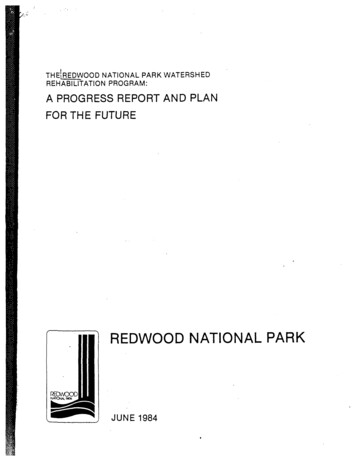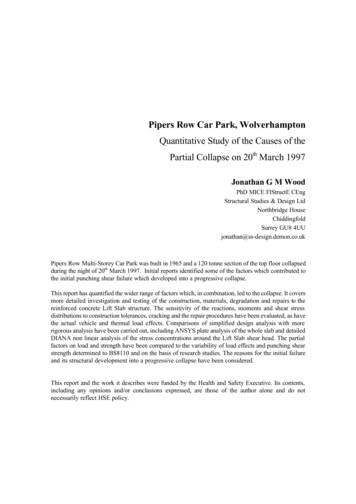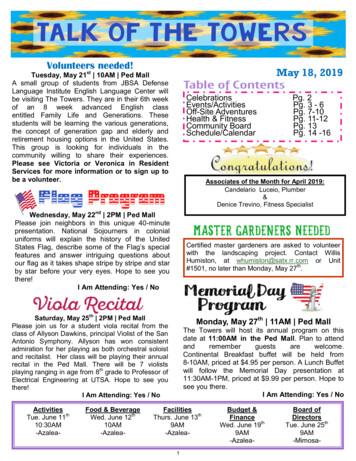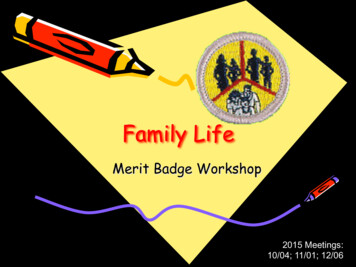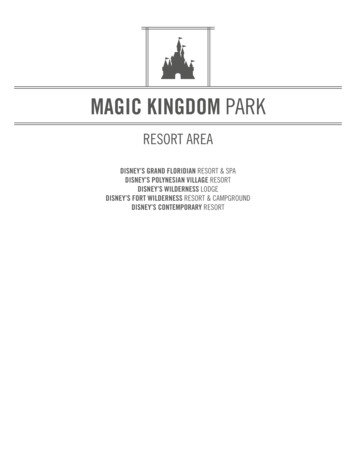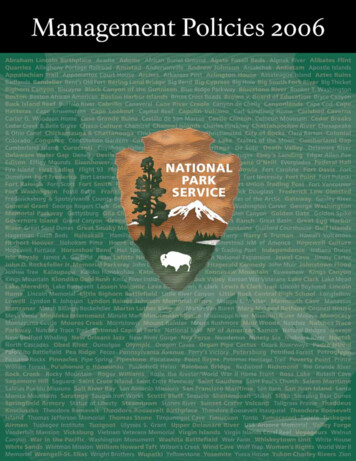
Transcription
Management of National Park Service ProgramsThis volume of Management Policies focuses exclusively on management of thenational park system. Beyond managing the national park system, the NationalPark Service administers a broad range of programs that serve the conservation andrecreation needs of the nation and the world. Examples include the following: National Register of Historic Places National Historic Landmarks Program National Natural Landmarks Program Land and Water Conservation Fund Grants Program Historic American Buildings Survey Historic American Engineering Record Historic American Landscapes Survey American Battlefield Protection Program National Maritime Heritage Grants Program Rivers, Trails and Conservation Assistance Program Tribal Heritage Preservation Grants Program Preserve America Grants Program National Heritage Areas ProgramAlthough these programs operate mainly outside the national parks, they form avital part of the National Park Service mission. Information about the policies andprocedures that govern these programs may be obtained from the appropriate NPSprogram managers (who are generally located in Washington, D.C.), or by visitingthe NPS web site at www.nps.gov.U.S. Department of the InteriorThe Department of the Interior protects and manages the nation’s naturalresources and cultural heritage; provides scientific and other information aboutthose resources; and honors its special responsibilities to American Indians, AlaskaNatives, and affi liated Island Communities.National Park ServiceThe National Park Service preserves unimpaired the natural and culturalresources and values of the national park system for the enjoyment, education,and inspiration of this and future generations. The National Park Servicecooperates with partners to extend the benefits of natural and cultural resourceconservation and outdoor recreation throughout this country and the world.
ManagementPolicies2006 U.S. Department of the Interior National Park Service
U.S. GOVERNMENT OFFICIAL EDITION NOTICEUse of ISBN Prefi x. This is the Official U.S. Government edition of this publicationand is herein identified to certify its authenticity. Use of the 0-16-076874-8 ISBN isfor U.S. Government Printing Office Official Editions only. The Superintendent ofDocuments of the U.S. Government Printing Office requests that any reprinted editionclearly be labeled as a copy of the authentic work with a new ISBN.Legal Status and Use of Seals and Logos. The Arrowhead symbol of the National ParkService authenticates Management Policies 2006 as the National Park Service’s officialguide to managing national parks. The National Park Service symbol is protected under18 USC 701, 15 USC 1051 et seq, and regulations published in 36 CFR Part II. The useof the National Park Service Arrowhead symbol on any republication of this materialwithout the express, written permission of the Director of the National Park Service isprohibited. Any person using the National Park Service symbol in a manner inconsistentwith the provisions of 36 CFR Part II is subject to the penalties specified in 18 USC 701.For sale by the Superintendent of Documents, U.S. Government Printing OfficeInternet: bookstore.gpo.gov Phone: toll free (866) 512-1800; DC area (202) 512-1800Fax: (202) 512-2104 Mail: Stop IDCC, Washington, DC 20402-0001ISBN 0-16-076874-8
Table of ContentsManagement Policies1The Guide to Managing theNational Park SystemUnderlying Principles12Introduction3Law, Policy, and Other GuidanceHierarchy of AuthoritiesPolicy DevelopmentCompliance, Accountability,and EnforceabilityThe Directives SystemOther Sources of GuidanceNPS Program Policies3441.9.41.9.51.9.5.11.9.5.21.9.5.344551.10 Partnerships1.11 Relationship withAmerican Indian Tribes1 The 11.21.11.3Managing Information16Information Sharing16Proprietary Information16Information Confidentiality16Accessibility for Persons with Disabilities17Public Information and Media Relations 17Management Accountability17Financial Sustainability17Facilities18Budget Performance andAccountability ultationTrust Resources18191919191.1 The National Park Idea81.21.31.3.11.3.21.3.31.3.48889992 Park System Planning21102.1 General Principles2222102.1.12.1.2The National Park SystemCriteria for InclusionNational SignificanceSuitabilityFeasibilityDirect NPS Management1.4 Park .71.4.7.11.4.7.2The Laws Generally GoverningPark Management“Impairment” and “Derogation”:One StandardThe NPS Obligation to Conserveand Provide for Enjoyment ofPark Resources and ValuesPark Purposes and LegislativelyAuthorized UsesThe Prohibition on Impairmentof Park Resources and ValuesWhat Constitutes Impairmentof Park Resources and ValuesWhat Constitutes ParkResources and ValuesDecision-making Requirements toIdentify and Avoid ImpairmentsUnacceptable ImpactsImproving Resource Conditionswithin the Parks102.1.32.1.4222222102.2 Major Elements of Park Planningand Decision-making22112.3 Levels of Park Planning23111111121212131.6 Cooperative ConservationBeyond Park Boundaries131.7 Civic Engagement141.8 Environmental Leadership141.9 Management .1.51.9.1.62020Decision-makingScientific, Technical,and Scholarly AnalysisPublic ParticipationGoal Orientation1.5 Appropriate Use of the ParksHuman ResourcesCareer Development, Training,and ManagementSuccession PlanningWorkforce PlanningEmployee Safety and HealthWorkforce DiversityVolunteers in the Parks1.12 Native Hawaiians, Pacific Islanders,and Caribbean Islanders1.13 An Enduring al Management Planning23Statutory Requirements24Management Zoning24Planning Team24Science and Scholarship24Public Involvement24Alternative Futures25Environmental Analysis25Cooperative Planning25Wild and Scenic Rivers25Wilderness25Alaska Park Units26Periodic Review ofGeneral Management Plans26Program Management Planning26Strategic Planning26Relationship between the Strategic Planand the General Management Plan27Implementation Planning27Environmental Analysis27Park Annual Performance27Planning and Reporting273 Land Protection3.1 General3.2 Land Protection Methods3.3 Land Protection Plans29303030
IVMANAGEMENT POLICIES 20063.43.53.63.73.8Cooperative ConservationBoundary AdjustmentsLand Acquisition AuthorityLand Acquisition FundingCondemnation4 Natural Resource ManagementIntroduction4.1 General Management 2.4353636Planning for Natural ResourceManagement37Natural Resource Information38Evaluating Impacts on Natural Resources38Partnerships38Restoration of Natural Systems39Compensation for Injuries to NaturalResources394.2 Studies and Collections4.2.1313132323339NPS-conducted or -sponsored Inventory,Monitoring, and Research Studies40Independent Studies40Natural Resource Collections41Collection Associated with theDevelopment of Commercial Products 414.3 Special 1414141424242Research Natural AreasExperimental Research AreasWilderness AreasNational Wild and Scenic Rivers SystemNational Natural LandmarksBiosphere ReservesWorld Heritage List4.4 Biological Resource 4.4.54.4.5.14.4.5.24.4.5.34.4.5.44.4.5.5General Principles for ManagingBiological ResourcesPlant and Animal PopulationManagement PrinciplesGenetic ResourceManagement PrinciplesDefinition of Native and Exotic SpeciesManagement of Native Plantsand AnimalsNPS Actions That RemoveNative Plants and AnimalsRestoration of Native Plantand Animal SpeciesManagement of Threatened orEndangered Plants and AnimalsManagement of Natural LandscapesMaintenance of AlteredPlant CommunitiesHarvest of Plants andAnimals by the PublicManagement of Exotic SpeciesIntroduction or Maintenanceof Exotic SpeciesRemoval of Exotic SpeciesAlready PresentPest ManagementPestsIntegrated Pest Management ProgramPesticide UseBiological Control Agents andBioengineered ProductsPesticide Purchase and Storage4.5 Fire Management4.6 Water Resource Management4.6.14.6.24.6.34.6.44.6.54.6.6Protection of Surface Watersand GroundwatersWater RightsWater QualityFloodplainsWetlandsWatershed and Stream Processes4.7 Air Resource Management524.7.14.7.2Air QualityWeather and Climate52534.8 Geologic Resource 53545454544.8.2.24.8.2.34.8.2.4Protection of Geologic ProcessesShorelines and Barrier IslandsKarstGeologic HazardsManagement of Geologic FeaturesPaleontological Resourcesand Their ContextsCavesGeothermal andHydrothermal ResourcesSoil Resource Management545555564.9 Soundscape Management564.10 Lightscape Management574.11 Chemical Information and Odors575 Cultural Resource ManagementIntroduction5.1 Research5960605.1.15.1.25.1.3NPS Research60Independent Research61Identification and Evaluationof Resources615.1.3.1Inventories615.1.3.2Evaluation and Categorization625.1.3.2.1 National Register Nomination625.1.3.2.2 National Historic Landmark Designation 625.1.3.2.3 Nominations for World HeritageList Designation625.2 Planning63425.2.15.2.25.2.3636464435.3 ion and Preservation ofCultural ResourcesEmergency ManagementFire Detection, Suppression, andPost-fire Rehabilitation and ProtectionCompensation for Injuries toCultural ResourcesEnvironmental Monitoring and ControlPest ManagementVisitor Carrying CapacityCultural Soundscape ManagementPhysical Access for Personswith DisabilitiesHistoric Property Leases andCooperative AgreementsStewardship of Human Remainsand BurialsTreatment of Cultural ResourcesArcheological ResourcesPreservationStabilizationRehabilitation, Restoration,and ReconstructionProtectionArcheological Data RecoveryEarthworksSubmerged Cultural ResourcesCultural onstruction ofObliterated LandscapesBiotic Cultural ResourcesLand Use and Ethnographic ValueNew ConstructionEthnographic ResourcesResource Access and 970707071
5.35.3.5.5.45.3.5.5.55.3.5.5.6Sacred SitesResearchHistoric and Prehistoric onstruction of Missing StructuresMovement of Historic StructuresNew ConstructionUse of Historic StructuresPark Structures Owned orManaged by OthersDamaged or DestroyedHistoric StructuresHistoric and Prehistoric RuinsMuseum isition, Management,Disposition, and UseHistoric FurnishingsArchives and Manuscripts6 Wilderness Preservationand Management6.1 General Statement6.2 Identification and Designationof the Wilderness 2.26.2.36.2.4Assessment of Wilderness Eligibilityor IneligibilityPrimary Eligibility CriteriaAdditional Considerations inDetermining EligibilityThe Assessment ProcessWilderness StudiesPotential WildernessProposed WildernessRecommended WildernessDesignated Wilderness6.3 Wilderness Resource 6.3.11.36.3.12General PolicyResponsibilityConsistencyWilderness-related Planningand Environmental ComplianceZoning for WildernessWilderness Management PlanningEnvironmental ComplianceMinimum RequirementScientific Activities in WildernessGeneral PolicyMonitoring Wilderness ResourcesNatural Resources ManagementCultural ResourcesFire ManagementManagement FacilitiesAdministrative FacilitiesTrails in WildernessShelters and CampsitesSignsWilderness BoundariesLegal Descriptions and Boundary MapsCavesWaters in WildernessAmerican Indian Accessand Associated .66.4.76.4.86.4.96.4.107 Interpretation and 5.27.5.389Interpretation and21st Century RelevancyAccess to Interpretive andEducational OpportunitiesResource Issue Interpretationand EducationResearch and ScholarshipEvaluation of Interpretationand Education EffectivenessConsultationCultural DemonstratorsHistoric 7.5.5787979797979807.5.67.5.77.5.87.5.97.6 Interpretive and EducationalPartnerships95807.6.1 Volunteers in Parks (VIPs)7.6.2 Cooperating 85858585858593949494948 Use of the Parks978.1 General988.1.18.1.298Appropriate UseProcess for DeterminingAppropriate Uses8.2 Visitor 866.4.3.16.4.3.26.4.3.36.4.46.4.58878786.4 Wilderness Use Management6.4.3Personal ServicesCurriculum-based Education ProgramsNonpersonal ServicesPark BrochuresTechnology and InterpretationInterpretive and Educational ServicesBeyond Park Boundaries7.4 Interpretive Competencies and Skills7.5 Requirements for All Interpretiveand Educational Services8.2.3.28.2.3.38.2.4General PolicyWilderness Interpretationand EducationRecreational Use Managementin WildernessRecreation Use EvaluationOutdoor Skills and EthicsUse of Motorized EquipmentCommercial ServicesSpecial Events87878888Introduction907.1 Interpretive and Educational Programs907.2 Interpretive Planning917.3 Personal and Nonpersonal Services917878Existing Private RightsGrazing and Livestock DrivewaysRights-of-WayMineral DevelopmentAccessibility for Personswith .5.48.2.5.58.2.5.68.2.6Visitor Carrying CapacityRecreational ActivitiesManagement of Recreational UseCommercial Visitor ServicesRiver UseBackcountry UseFishingHunting and TrappingParachutingRecreational Pack andSaddle Stock UseUse of Motorized EquipmentMotorized Off-roadVehicle UseSnowmobilesPersonal Watercraft UseAccessibility for Personswith DisabilitiesVisitor Safety andEmergency ResponseVisitor SafetyEmergency Preparedness andEmergency OperationsSearch and RescueDive OperationsPublic Health ProgramEmergency Medical ServicesRecreation Fees and 04104104104105105105106106106106106VTABLE OF CONTENTS 3-4 – .4.8
VI8.2.6.18.2.6.2MANAGEMENT POLICIES 20068.2.7Recreation FeesNational RecreationReservation ServiceTourism1078.12 28.3 Law Enforcement 68.4.78.4.88.5GeneralThe Context for Law EnforcementShared ResponsibilitiesEnforcement AuthorityJurisdictionUse of ForceLaw Enforcement Public Informationand Media RelationsHomeland SecurityOverflights and Aviation UsesAlaska and Remote AreasEducationGeneral AviationAdministrative UseMilitary AviationCommercial Air Tour ManagementPermitted OverflightsAirports and Landing SitesUse by American Indians and OtherTraditionally Associated Groups1091091091101101101101101101101101118.6 Special Park 112112112112113113113113113113114114Additional CriteriaPrior ApprovalNoncompetitive AwardsHistoric Properties9 Park Facilities1239.1 .1.3.39.1.49.1.4.19.1.4.2Facility Planning and DesignLife-cycle CostsIntegration of Facilitiesinto the Park EnvironmentProtection of Cultural ValuesAdaptive UseSiting Facilities to AvoidNatural HazardsSustainable Energy DesignAccessibility for Personswith DisabilitiesConstructionConstruction SitesRevegetation and LandscapingBorrow Pits and Spoil AreasMaintenanceGeneralAcquisition of EnvironmentallyPreferable and Energy-EfficientProductsUtilitiesWater Supply SystemsWastewater TreatmentSystemsUtility LinesHistoric UtilitiesWaste Managementand Contaminant IssuesWaste ManagementNPS Response to ContaminantsEnergy ManagementStructural Fire Protectionand SuppressionGeneralRequests for PermitsFeesSpecial EventsGeneralHelium-filled BalloonsFireworks DisplaysSale of Food or MerchandiseFirst Amendment ActivitiesRights-of-Way for Utilities and RoadsGeneralUtilitiesTelecommunication SitesRoads and Highways andPetroleum-based Pipelines8.6.5Access to Private Property8.6.6Filming and Photography8.6.6.1General8.6.6.2Permits and Fees8.6.6.3NPS Participation8.6.7Agricultural Uses8.6.8Domestic and Feral Livestock8.6.8.1General8.6.8.2Managing Agricultural Grazing8.6.8.2.1 Permitting Agricultural Grazing8.6.8.2.2 Structures for Agricultural Grazing8.6.8.3Trespass and Feral Livestock8.6.9Military Operations8.6.10Cemeteries and Burials8.6.10.1 National Cemeteries8.6.10.2 Family Cemeteries8.6.10.3 Other Burials and theScattering of Ashes8.6.11Other Special Park Uses1171188.7 Mineral Explorationand Development1188.7.18.7.28.7.31181181199.3 Visitor Facilities8.8 Collecting Natural 1.69.3.1.79.3.2Mining ClaimsFederal Mineral LeasesNonfederally Owned 1171171178.9 Consumptive Uses1198.10 Natural and Cultural Studies,Research, and Collection Activities8.11 Social Science eneralNPS-supported StudiesIndependent and Commercial StudiesManagement and Conduct of .19.1.6.29.1.79.1.89.2 Transportation Systems andAlternative 1.2.1Road Systems132Park Roads132Non-NPS Roads132Existing Commercial andOther Through-Traffic1339.2.1.2.2 Construction and Expansion Proposals 1339.2.2Trails and Walks1339.2.2.1Cooperative Trail Planning1339.2.2.2Hiking Trails1349.2.2.3Equestrian Trails1349.2.2.4Bicycle Trails1349.2.2.5Water Trails1349.2.2.6Interpretive Trails1349.2.2.7National Trails1349.2.2.8Trailheads1349.2.2.9Trail Bridges1349.2.3Traffic Signs and Markings1359.2.4Parking Areas1359.2.5Navigation Aids1359.3.19.3.2.19.3.2.2Informational andInterpretive FacilitiesSignsEntrance StationsVisitor CentersAmphitheatersWayside ExhibitsViewing DevicesFacilities for Arts and CultureOvernight Accommodationsand Food ServicesCampgroundsBackcountry Campsites135135135135136136136136136136136137
Hostels and SheltersComfort StationsOther Visitor FacilitiesPicnic and Other Day Use AreasFacilities for Water RecreationSkiing FacilitiesAdvertising1371371371371381381389.4 Management .39.4.3.49.4.49.4.5Administrative OfficesMuseum CollectionsManagement FacilitiesEmployee HousingHousing Management PlanEligible ResidentsHistoric StructuresDesign and ConstructionMaintenance StructuresMiscellaneous Management Facilities1391391391391391391391399.5 Dams and Reservoirs1409.6 Commemorative Worksand erpretive Works ThatCommemorateApproval of Commemorative WorksPreexisting Commemorative WorksDonated Commemorative WorksCommemorative Works inNational Cemeteries10 Commercial Visitor 2 1Concession PoliciesCommercial Visitor ServicesPlanningConcess
Service authenticates . Management Policies 2006. as the National Park Service’s offi cial guide to managing national parks. The National Park Service symbol is protected under 18 USC 701, 15 USC 1051 et seq, and regulations published in 36 CFR Part II. The use of the National Park Service
